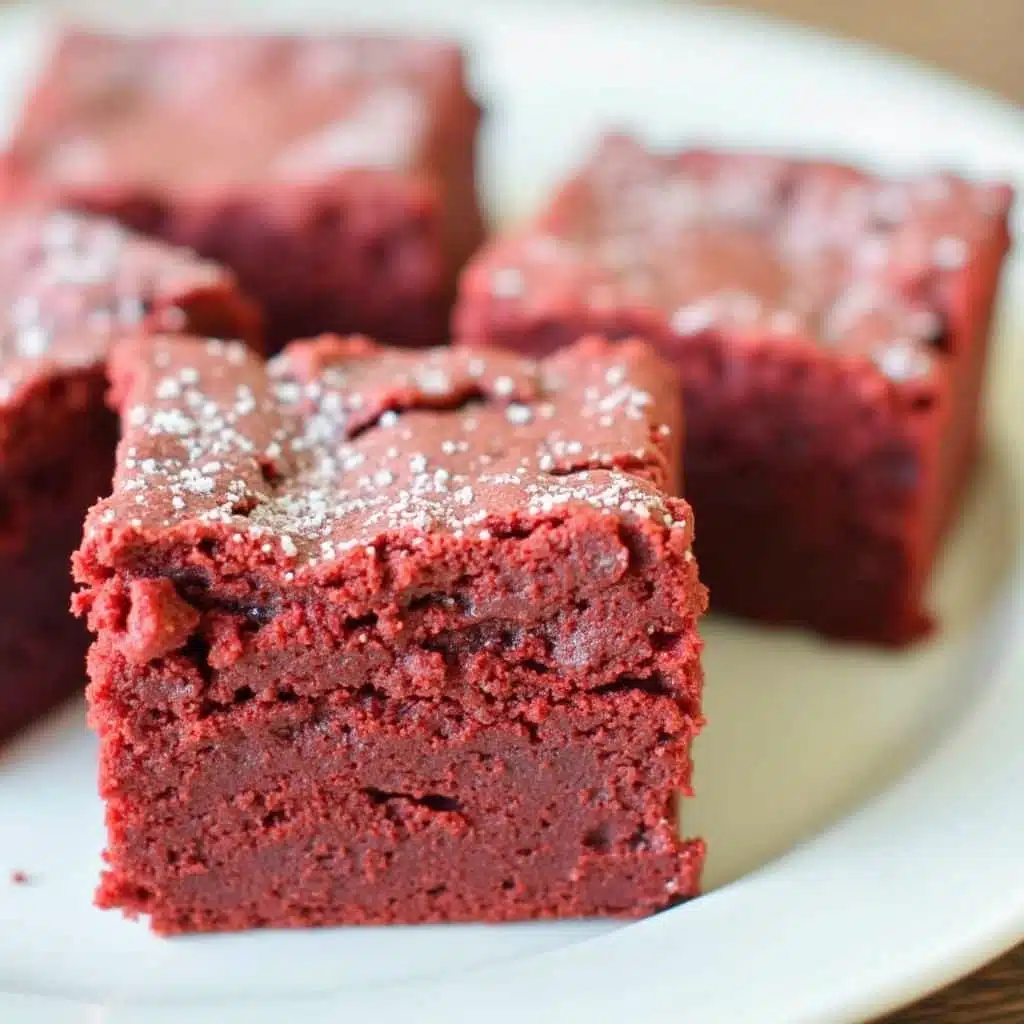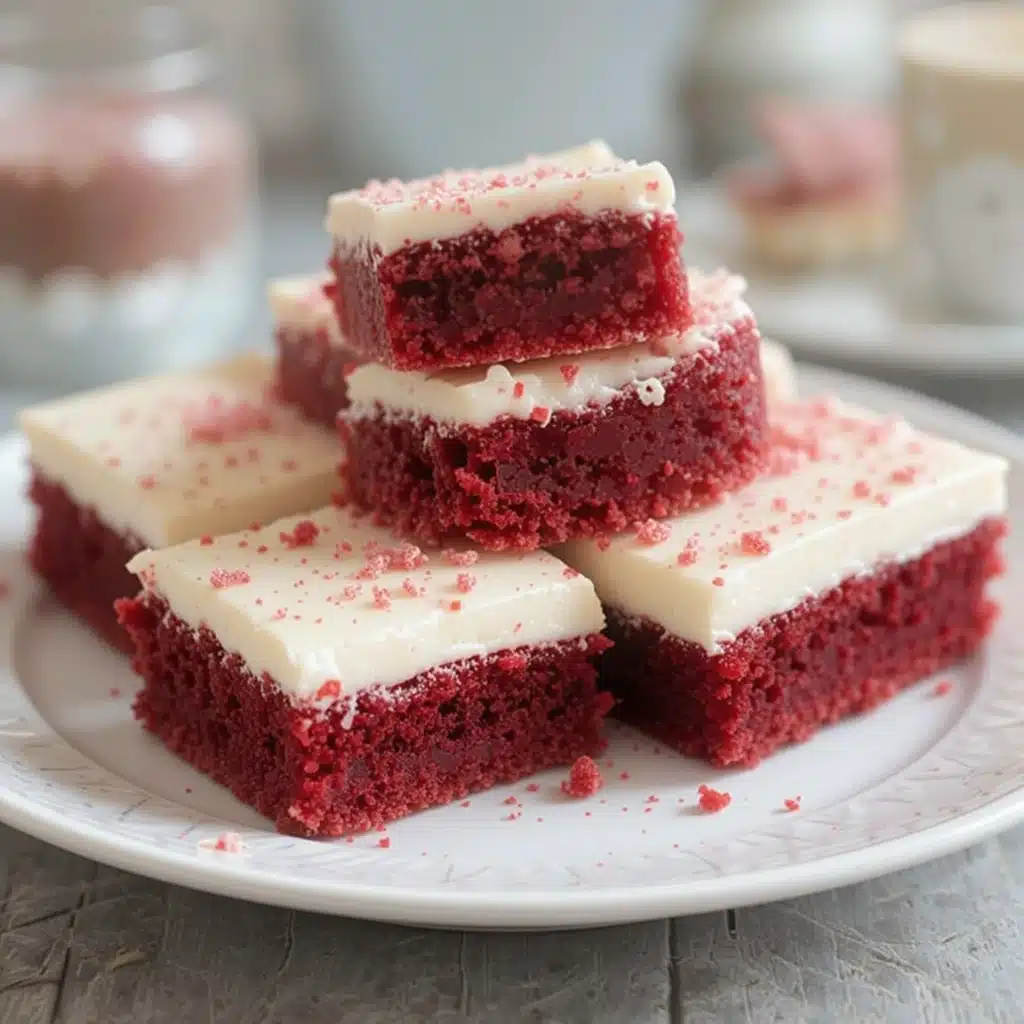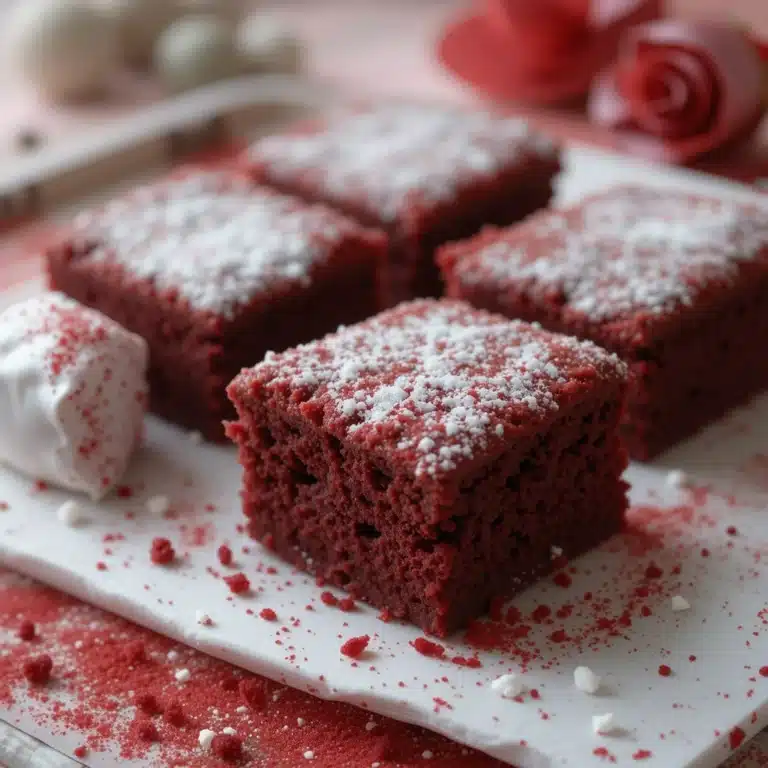Red Velvet Brownies are more than just a dessert—they’re a nostalgic journey wrapped in rich, fudgy chocolate and the vibrant allure of red velvet cake. I still remember the first time I tasted this magical combination: the perfect balance of dense, chewy brownie and the subtle cocoa tang of red velvet, topped with a luscious cream cheese swirl. It was a moment of pure bliss that instantly became a favorite in my kitchen.
This irresistible fusion combines the best of both worlds—brownies’ deep chocolate richness and red velvet’s striking color and delicate flavor. In this article, I’ll take you through the origins of these classic treats, unpack the science behind their unique textures, and share my step-by-step guide to baking Red Velvet Brownies that wow every time. Whether you’re a seasoned baker or just starting out, you’ll have all the tools to create this showstopper dessert that’s sure to bring smiles and sweet memories to your table.
Table of Contents
Table of Contents
The Origins of Brownies
A Brief History
The brownie, as we know it today, is a relatively recent invention in the grand timeline of culinary history. The first recorded recipe for brownies appeared in the 1896 edition of the “Boston Cooking-School Cook Book” by Fannie Merritt Farmer. However, these early brownies were more like a dense, chocolate cake than the fudgy, chewy treats we enjoy today.
The exact origins of the brownie are somewhat murky, with several competing theories. One popular story suggests that brownies were created by a chef at the Palmer House Hotel in Chicago in 1893. The chef was asked to create a dessert that could be easily packed in boxed lunches for the World’s Columbian Exposition. The result was a dense, chocolatey bar that could be eaten with the hands, and thus, the brownie was born.
The Evolution of Brownies
Over the years, brownies have evolved into a versatile dessert with countless variations. From the classic fudgy brownie to the cakey version, and even blondies (which are made without cocoa), brownies have become a canvas for creativity in the kitchen. Add-ins like nuts, chocolate chips, and swirls of caramel or peanut butter have further expanded the possibilities.
The key to a great brownie lies in the balance of ingredients. The ratio of flour to fat (usually butter) to sugar determines whether a brownie will be fudgy, cakey, or somewhere in between. The type of chocolate used—whether it’s unsweetened, bittersweet, or semi-sweet—also plays a crucial role in the final flavor and texture.
The Origins of Red Velvet Cake
A Southern Classic
Red velvet cake is a dessert that has become synonymous with Southern hospitality and celebration. Its origins, like those of the brownie, are somewhat disputed. Some believe that red velvet cake was first created in the early 20th century, while others trace its roots back to the Victorian era.
One popular theory is that red velvet cake was born out of the Great Depression, when bakers used beet juice to enhance the color and moisture of their cakes. Another theory suggests that the cake’s distinctive red color was a result of a chemical reaction between natural cocoa powder (which contains anthocyanin, a pH-sensitive antioxidant) and acidic ingredients like buttermilk and vinegar.
The Rise to Fame
Red velvet cake gained widespread popularity in the mid-20th century, thanks in part to the Adams Extract Company, which marketed red food coloring as a way to achieve the cake’s signature hue. The cake’s popularity was further cemented when it was featured in the 1989 film “Steel Magnolias,” where a red velvet armadillo-shaped groom’s cake became an iconic symbol of Southern culture.
The classic red velvet cake is characterized by its vibrant red color, subtle cocoa flavor, and tangy cream cheese frosting. The combination of flavors and textures makes it a standout dessert that continues to captivate bakers and dessert lovers alike.
The Science of Red Velvet Brownies
The Perfect Fusion
Red Velvet Brownies are a harmonious blend of the rich, chocolatey goodness of brownies and the unique flavor profile of red velvet cake. The key to achieving this perfect fusion lies in understanding the science behind both desserts.
The Role of Cocoa
Cocoa powder is a crucial ingredient in both brownies and red velvet cake. In brownies, cocoa powder provides the deep chocolate flavor that defines the dessert. In red velvet cake, cocoa powder is used in smaller quantities to give the cake a subtle chocolate undertone without overpowering the other flavors.
When making Red Velvet Brownies, it’s important to strike the right balance of cocoa powder. Too much cocoa can overwhelm the delicate flavor of the red velvet, while too little can result in a brownie that lacks depth. A combination of natural cocoa powder and a small amount of melted chocolate can help achieve the perfect balance.
The Importance of Acid
One of the defining characteristics of red velvet cake is its slight tanginess, which comes from the use of acidic ingredients like buttermilk and vinegar. These ingredients not only enhance the flavor but also react with the cocoa powder to bring out the cake’s signature red color.
In Red Velvet Brownies, the addition of buttermilk and a small amount of vinegar is essential to achieving the tangy flavor and vibrant color that set these brownies apart from traditional chocolate brownies. The acid also helps to tenderize the crumb, resulting in a brownie that is both fudgy and moist.
The Role of Food Coloring
While the natural reaction between cocoa powder and acidic ingredients can produce a reddish hue, most modern recipes for red velvet cake and brownies rely on red food coloring to achieve the vibrant red color that is so visually appealing. When making Red Velvet Brownies, it’s important to use a high-quality food coloring to ensure that the color is consistent and doesn’t fade during baking.
The Cream Cheese Swirl
No discussion of red velvet desserts would be complete without mentioning cream cheese. The tangy, creamy flavor of cream cheese frosting is the perfect complement to the subtle cocoa flavor of red velvet cake. In Red Velvet Brownies, a cream cheese swirl adds a luxurious touch that elevates the dessert to new heights.
The cream cheese swirl is made by combining softened cream cheese with sugar, an egg, and a bit of vanilla extract. This mixture is then swirled into the brownie batter before baking, creating a marbled effect that is as beautiful as it is delicious.

How to Make Red Velvet Brownies
Now that we’ve explored the history and science behind Red Velvet Brownies, it’s time to roll up our sleeves and get baking. Below is a step-by-step guide to making the perfect Red Velvet Brownies at home.
Ingredients
For the Brownie Batter:
- 1 cup (2 sticks) unsalted butter, melted
- 2 cups granulated sugar
- 4 large eggs
- 2 teaspoons vanilla extract
- 1/4 cup natural cocoa powder
- 2 tablespoons red food coloring (gel or liquid)
- 1 teaspoon white vinegar
- 1/2 teaspoon salt
- 1 1/4 cups all-purpose flour
For the Cream Cheese Swirl:
- 8 ounces cream cheese, softened
- 1/4 cup granulated sugar
- 1 large egg
- 1/2 teaspoon vanilla extract
Instructions
Step 1: Preheat the Oven
Preheat your oven to 350°F (175°C). Grease a 9×13-inch baking pan with butter or cooking spray, then line it with parchment paper, leaving an overhang on the sides for easy removal.
Step 2: Prepare the Brownie Batter
- In a large mixing bowl, whisk together the melted butter and sugar until well combined.
- Add the eggs one at a time, whisking well after each addition.
- Stir in the vanilla extract, cocoa powder, red food coloring, and vinegar. Mix until the batter is smooth and evenly colored.
- Gently fold in the salt and flour, being careful not to overmix. The batter should be thick and glossy.
Step 3: Prepare the Cream Cheese Swirl
- In a medium mixing bowl, beat the softened cream cheese until smooth.
- Add the sugar, egg, and vanilla extract, and beat until well combined and creamy.
Step 4: Assemble the Brownies
- Pour the brownie batter into the prepared baking pan, spreading it evenly with a spatula.
- Drop spoonfuls of the cream cheese mixture over the brownie batter.
- Use a knife or skewer to swirl the cream cheese mixture into the brownie batter, creating a marbled effect.
Step 5: Bake the Brownies
- Place the pan in the preheated oven and bake for 25-30 minutes, or until a toothpick inserted into the center comes out with a few moist crumbs (but not wet batter).
- Be careful not to overbake, as this can result in dry brownies.
Step 6: Cool and Serve
- Allow the brownies to cool completely in the pan before lifting them out using the parchment paper overhang.
- Cut into squares and serve. For an extra touch of indulgence, you can drizzle the brownies with a simple glaze made from powdered sugar and milk, or serve them with a scoop of vanilla ice cream.
If you love creamy desserts, consider trying our Madeline cookies recipe using cream
Tips for Perfect Red Velvet Brownies
- Use High-Quality Ingredients: The quality of your ingredients will have a significant impact on the final result. Use high-quality cocoa powder, cream cheese, and food coloring for the best flavor and color.
- Don’t Overmix the Batter: Overmixing can lead to tough brownies. Mix the batter just until the ingredients are combined.
- Check for Doneness: Brownies continue to cook as they cool, so it’s better to slightly underbake them than to overbake. A toothpick inserted into the center should come out with a few moist crumbs, but not wet batter.
- Let Them Cool Completely: It can be tempting to cut into the brownies right away, but allowing them to cool completely will make them easier to cut and will help the flavors to develop.
- Experiment with Add-Ins: While the classic Red Velvet Brownie is delicious on its own, you can experiment with add-ins like white chocolate chips, chopped nuts, or even a swirl of raspberry jam for a unique twist.

Variations on Red Velvet Brownies
Once you’ve mastered the basic Red Velvet Brownie recipe, the possibilities for customization are endless. Here are a few ideas to inspire your next batch:
Red Velvet Cheesecake Brownies
For an extra indulgent treat, try adding a layer of cheesecake to your Red Velvet Brownies. Simply prepare a basic cheesecake batter (cream cheese, sugar, egg, and vanilla) and spread it over the brownie batter before swirling. Bake as directed, and you’ll have a decadent dessert that combines the best of both worlds.
Red Velvet Brownie Bites
If you’re looking for a bite-sized treat, consider making Red Velvet Brownie Bites. Use a mini muffin pan to bake the brownies, and top each one with a dollop of cream cheese frosting. These are perfect for parties or as a sweet snack on the go.
Red Velvet Brownie Trifle
For a show-stopping dessert, layer chunks of Red Velvet Brownies with whipped cream and fresh berries in a trifle dish. The combination of textures and flavors makes for a dessert that is as beautiful as it is delicious.
Red Velvet Brownie Ice Cream Sandwiches
Take your Red Velvet Brownies to the next level by turning them into ice cream sandwiches. Simply bake the brownies in a square pan, let them cool, and then cut them into squares. Sandwich a scoop of your favorite ice cream between two brownie squares, and enjoy!
Conclusion
Red Velvet Brownies are a delightful fusion of two classic desserts, combining the rich, chocolatey goodness of brownies with the unique flavor and vibrant color of red velvet cake. Whether you’re a seasoned baker or a novice in the kitchen, this recipe is sure to impress. With a few simple ingredients and a bit of patience, you can create a dessert that is as beautiful as it is delicious.
So why not give Red Velvet Brownies a try? Whether you’re baking for a special occasion or just treating yourself to a sweet indulgence, these brownies are sure to become a new favorite in your dessert repertoire. Happy baking!

